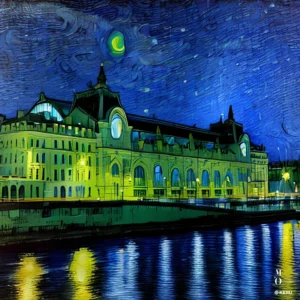In 2021, Musée d’Orsay, the eminent Parisian establishment housing the world’s largest collection of Impressionist and Post-Impressionist masterpieces, found itself grappling with dwindling visitor numbers in the fluctuating climate of Covid lockdowns. Despite optimistic notions within the staff about the intrinsic French devotion to cultural pursuits, the expected resurgence in attendance did not materialize post-lockdowns.
Reaching New Demographics
“French people came less, young people came less,” shared Guillaume Roux, the Orsay’s Director of Development. With the inception of a new president, Christophe Leribault, in October 2021, there was an intensified resolve to make the museum more accessible and inclusive. The objective was clear—engage with a diverse audience, including those unfamiliar or unacquainted with the museum.
To rejuvenate the museum’s appeal and draw younger audiences, Leribault initiated an exploration into blockchain and NFTs, technologies creating ripples in the artistic community. The culmination of this exploration is a novel partnership with the Tezos Foundation, aiming to integrate blockchain-backed artworks and digital artists with the museum’s exhibitions and collections.

Blending Tradition with Innovation
Kicking off this collaboration, the museum is launching digital souvenirs for the upcoming exhibition, “Van Gogh in Auvers-sur-Oise: The Final Months,” opening on October 3. These souvenirs, minted on the Tezos blockchain, include an augmented reality depiction of van Gogh’s final palette and an original digital artwork by KERU, reflecting van Gogh’s influence.
The museum aims to offer a blend of traditional art and contemporary digital interpretations, providing patrons and online collectors with immersive and gamified experiences, along with opportunities to win exclusive prizes like lifetime passes to the Orsay.
Educational Ventures and Digital Collaborations
This partnership extends beyond unique exhibits to encompass a series of conferences and learning programs centered around emerging technologies. Additionally, from 2024, the Orsay plans to invite digital artists from the blockchain to create NFT collections inspired by its timeless pieces, a strategy paralleling the initiatives at the Los Angeles County Museum of Art (LACMA).
Valerie Whitacre of TriliTech, who collaborated with the Orsay on its blockchain initiatives, perceives these endeavors as harmonious with the museum’s roots in the Impressionist movement. She emphasizes the alignment of embracing crypto art with the museum’s historical affinity for non-traditional artistic expressions and innovations.
Adapting to Contemporary Tastes
While the museum has regained its pre-pandemic popularity, ranking as the tenth-most visited museum globally, the staff perceive their technological foray as an advantageous pivot induced by the pandemic. For Roux, the endeavor is less about increasing visitor volume and more about modernizing the museum’s approach, resonating with new generations and ensuring the museum’s relevance and resonance in contemporary dialogues.
The Musée d’Orsay’s immersion into blockchain and NFTs signifies a broader transformation within the art and cultural sectors, reflecting a recognition of the imperatives to innovate, adapt, and converse with evolving audience preferences and the diversified mediums of artistic expression in the 21st century. It encapsulates the essence of balancing heritage with innovation, offering a multidimensional perspective on art in an increasingly digital era. The initiatives underline the crucial dialogue between tradition and modernity, ensuring that century-old institutions remain relevant in an evolving cultural landscape.




What’s up mates, its great article on the topic of educationand fully explained, keep it up all the time.